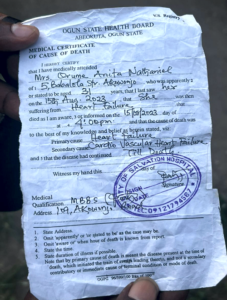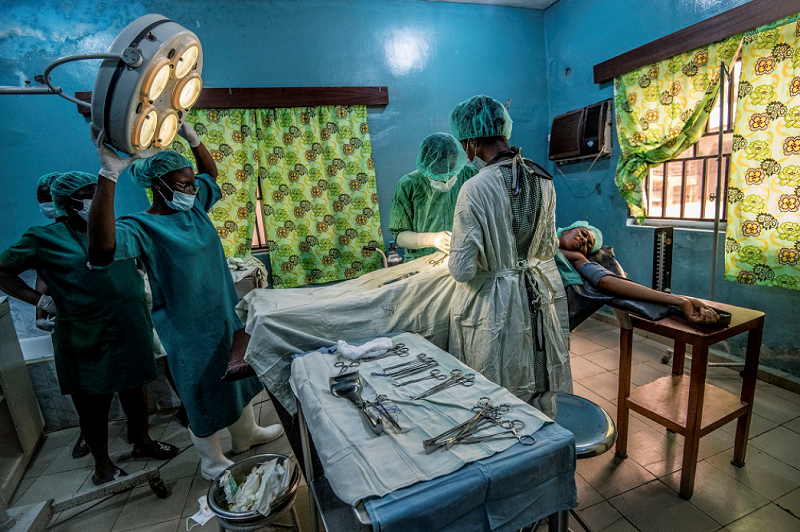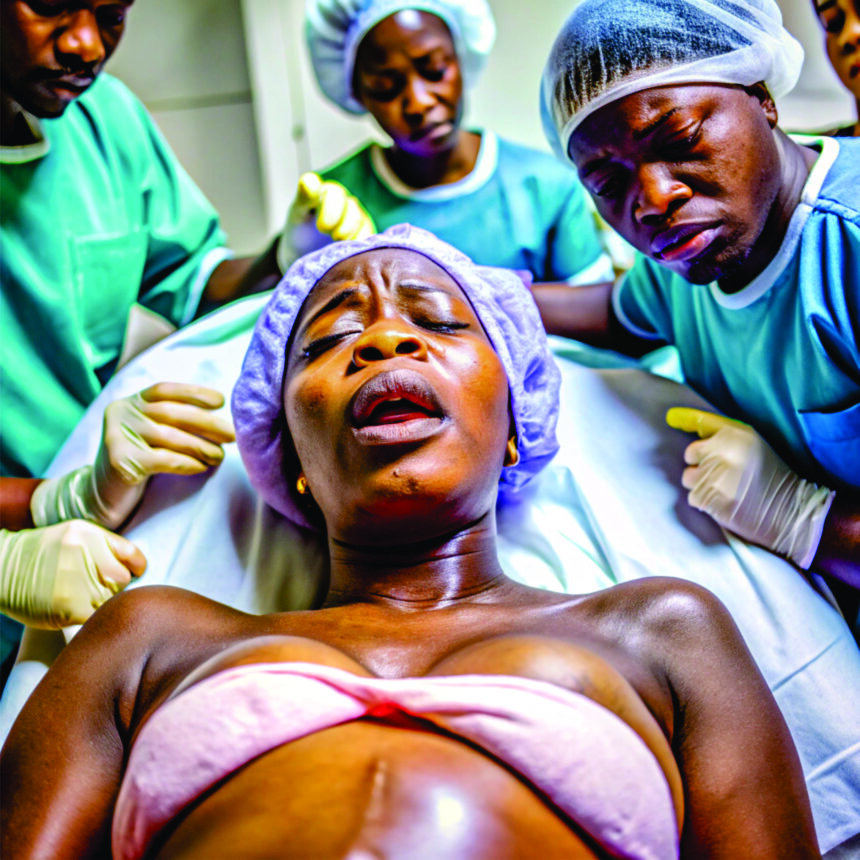• Young, pregnant, dead: Inside The Deathly Maternity Wards of City of Salvation Hospital
• Shady: Lagos clinic issues Ogun death certificate for victim of botched surgery, doctors medical records
• Why dead mothers, injured wives litter Nigeria’s labour rooms
Yet, the knife did not pause. The hands of Dr. Okusanya Abimbola pressed on, pulling and tearing, parting her flesh roughshod, scraping through her insides as though her pain was no more than the distant chirp of a cricket at dawn. As the surgeon’s hands dug deeper, Anita’s wails faded, swallowed by the clatter that enveloped the room like a funeral shroud, leaving only the refrain of the gospel song playing jarringly in the background: “I surrender to you, I surrender to you.” But in that theatre, it wasn’t Anita’s soul surrendering to divinity, the 32-year-old surrendered to the brute spunk of negligence.
Anita Nathaniel lay tethered to the surgical table, captive between life and death. There, beneath the stern glare of fluorescent lights, inside the City of Salvation Hospital, Egbeda, Lagos, a frantic opera unfurled, echoing the sombre notes that would cast her fate in a dark shroud.
Inside the medical theatre, an electronic speaker belched gospel song that whirled like a dirge through the air. “I surrender to you! I surrender to you!” the speaker blared.
Amid the cacophonous peal of faith and surrender, Anita stirred to the sharp intrusion of a knife cutting through her belly. Barely one minute into the caesarean section that would bring her child into the world, the haze of anaesthesia receded, and the cutting pain of the surgeon’s blade sliced through her body. As the scalpel grazed her abdomen, the world around her faded into a hazy abstraction, leaving only the visceral torture of the procedure.
With every thrust of the surgeon’s hands, gobs of flesh and innards were yanked aside in reckless abandon. And the theatre erupted in a carnage of blood and gore, as the colour red splattered in stark contrast against the sterile white of the sheets.
Anita gasped. Then she wailed: “Aargh! What are you doing to me? Stop! Don’t do that! Please, don’t do that! Jesus, please save me. I am in pain! Aargh! Aargh!” Her voice, ragged with agony, was met with chilling indifference. A voice, detached and careless, tossed a dispassionate word back into the abyss of her suffering: “Sorry.”
Yet, the knife did not pause. The hands of Dr. Okusanya Abimbola pressed on, pulling and tearing, parting her flesh roughshod, scraping through her insides as though her pain was no more than the distant chirp of a cricket at dawn. As the surgeon’s hands dug deeper, Anita’s wails faded, swallowed by the clatter that enveloped the room like a funeral shroud, leaving only the refrain of the gospel song playing jarringly in the background: “I surrender to you, I surrender to you.” But in that theatre, it wasn’t Anita’s soul surrendering to divinity, the 32-year-old surrendered to the brute spunk of negligence.
In the aftermath of that grisly ballet…
As the surgeon extracted the child from the ruins of the mother’s body, the air grew thick with a haunting stillness. Anita lay there, a broken vessel. Silence fell over her, like a shroud more tangible than the bloodied sheet that lay across her lifeless form. Was she gone? Or was she merely suspended in the throes of death, her spirit fighting to escape surgical torture? These questions lingered, unanswered, in the hushed theatre.
To the casual observer, the tableau was unthinkable—a macabre circus of sloppiness, where the doctor and his nursing assistant plowed Anita’s innards and tore through her flesh. A large wad of cotton wool was shoved into her gaping wound, and recklessly pulled out, in a futile effort to stanch the torrents of blood that gushed from her belly.
“I saw a nurse bring out three big bowls of blood during the operation,” recounted Evwiarivi Nathaniel, Anita’s husband, his voice quaking with unbearable grief. “I asked her what she intended to do with it, and she said she was going to pour it away,” said the chef and native of Ikeresan, Sapele, Delta State.
From the moment the theatre doors swung open, what followed was a scene bathed in confusion. Nurses scurried out of the operating room, their faces tense, yet they assured Nathaniel that, “Everything is fine.” But their restless feet told a different story. The minutes stretched into hours, each one more suffocating than the last, until finally, one of the nurses emerged with the fruit of Anita’s labour: her child, Jaden.
Nathaniel enquired about his wife, and the nurse replied that she was fine. “She said that I should just hold on to my new born baby,” he said, revealing his disappointment that the hospital had no baby cot to keep the child. Nathaniel’s heart clung to the newborn in his arms, but his wife’s absence gnawed at his spirit. “She’s fine,” resounded the assurance, hollow in its echo.
Time passed, too much time, and then, the truth hurtled from a nurse’s lips, like a dagger through his chest. Anita was gone. His beloved wife had bled out, distressed and lonely, on the surgical table.
Under the blade of silence
Until her death, Anita had cut a perfect picture of good health. Her antenatal checkups had shown no sign of complications even as her vitals echoed with promise of a safe delivery. “She couldn’t wait to birth our first child,” disclosed Nathaniel. But fate, draped in the sterile white of a surgical gown, had other plans.
Indeed, the City of Salvation Hospital was no stranger to Anita. Its cold halls had witnessed her belaboured plod through the delicate dance of pregnancy, each antenatal visit a rehearsal for the grand performance of birth. Yet when her water broke at 1:00 am on August 15, 2023, the future shimmered with hope and an undercurrent of unease. Nathaniel called the hospital but a nurse’s voice, seemingly draped in the sluggishness of night, urged him to wait till daybreak before he brought Anita in. But spurred by excitement and first-time naivety, Nathaniel spirited his wife to the clinic at 4:30 am. His heart heavy with anticipation and a subtle, creeping dread.
On getting to the hospital, a scan was conducted on Anita to determine the progression of her labour. But the 32-year-old was far from the image of fragility one might expect. She walked, she climbed stairs, did squats, guided by the nurse’s calm instructions. Her body, full of life, seemed ready for the gruelling birthing process ahead.
“At 9:00 am the nurse took my wife to run a scan, when the result was out, I took the result and scanned it to my brother, Amos Evwiarivi, so he could show his doctor friends to ascertain if everything was alright. My brother thereafter confirmed to me that his doctor friend said from the scan, everything was okay,” said Nathaniel. But this was a temporary salve to his growing unease – for soon, Ifedolu Oreitan, a nurse playing the role of a “resident doctor,” cast a shadow over the morning with his sudden suggestion of a caesarean section. Oreitan subsequently admitted in a court deposition that he examined Anita and concluded that the baby would be best delivered via a caesarean section. “I made my recommendation for c-section around 9:00 am that same day of August 15, 2023.” This was yet another interesting episode in the build up to the tragedy as Oreitan, being a nurse, lacked the professional and ethical capacity to recommend a procedure that was best determined by a qualified obstetric surgeon.
Nathaniel refused, stressing that he and his wife wanted her to have a normal vaginal delivery. Neither the innuendo of complicated labour or death scared Anita, in particular. And so, they waited. Anita, though now tethered to the hospital bed by a drip, seemed a pillar of strength. But as time stretched, her moans of discomfort grew intense, the pain writhing in her like a snake coiled in her belly.
Oreitan returned, more insistent now, his words ringing with an urgency that Nathaniel could not ignore. With his wife’s agony more evident, Nathaniel relented and paid N150,000 of a N300, 000 surgical bill. “After making the payment, I was assured that the surgeon would join them shortly. But my wife had to wait for well over eight hours before the surgeon arrived,” said Nathaniel.
The attending surgeon, Dr. Abimbola did not appear until late in the afternoon, he said. And when he finally did, it wasn’t with the air of urgency or in the careful assembly of a skilled team, but with Nurse Oreitan, and two auxiliary nurses. This was a flagrant violation of medical personnel specifications for a caeserean section: One obstetric surgeon, one assistant surgeon, an anaesthesiologist, a paediatrician, and two qualified nurses.
In the City of Salvation Hospital’s medical theatre, the crucial figure of an anesthesiologist was missing, an omission that would become the linchpin in the unfolding tragedy.
Although, Anita walked into the theatre by herself, hoping to reemerge hale and hearty with her baby, she didn’t. After waiting for a while one of their nurses came out and broke the sad news of her death to her husband. “It was traumatising for me. I became miserable and heartbroken, knowing my child had become motherless and left without motherly love,” said Nathaniel.
By the time his wife breathed her last, however, the dubious gear of deception was in full swing. A death certificate, hastily issued by the Ogun State Health Board—hundreds of miles from where Anita drew her last breath was handed to her husband, Nathaniel. The certificate, a pale slip of paper meant to account for Anita’s sudden death, raised more questions instead. Why an Ogun State death certificate, when Anita had died in Lagos? The answers lay in a cover-up meticulously crafted by the hospital.

What Anita experienced in her final hours
In Anita’s final moments, the anaesthesia evidently failed to maintain the necessary depth of unconsciousness, thus causing her to wake feel intense pain as the surgeon cut into her abdomen and manipulated her internal organs. Her body’s natural response to such extreme pain was to activate the fight or flight mechanism, increasing her heart rate, blood pressure, and stress hormone levels. However, in a patient weakened by childbirth, this physiological response can be dangerous. The massive loss of blood and initial surge in blood pressure (hypertension) could have caused damage, but as the surgery progressed and her blood loss increased, her blood pressure would have dropped dangerously low (hypotension). This hypotension reduced blood flow to vital organs, including the heart, kidneys, and brain, leading to potential organ failure, and subsequent death, argued an obstetric surgeon with a Lagos based university teaching hospital, who pleaded anonymity.
In other words, as the cold blade of the scalpel pierced the thin veil of Anita’s flesh, she should have been lost in the deep, dreamless sleep that “general anesthesia” promises—a twilight where pain and fear do not tread. But the anesthetic, meant to keep pain at bay, had thinned away, leaving her vulnerable to the sharp, unsparing stab of the surgeon’s blade.
When her eyes fluttered open on the surgical table, Anita must have felt like a lamb betrayed by its shepherd, waking to the jaws of a ravenous wolf. The searing agony that coursed through her veins was not just the sting of the incision, but the excruciating sensation of her flesh being parted, layer by tender layer, while her consciousness was trapped in a body that could not cry out, that could not flee. The nerves in her abdomen screamed in violent protest, sending shockwaves of unbearable pain into her spine, her limbs, her very soul. Her mind, swimming in the confusion of half-wakefulness, must have wrestled with the agony of it all—unable to comprehend how she could still feel, still hurt, while the very essence of life bled away from her. Hence her initial plea and wailing of being in pain.
Anita’s final moments were not just a medical catastrophe—they were an unutterable violation of the sanctity of life, a tearing of her soul from her body while still tethered to the torturous sensations of mortality. The surgeon, while doubling as an anesthetist, evidently lacked the competence to shield her from pain. Thus on his watch, Anita’s body, once a vessel of life and creation, became a crucible of unimaginable torment and death.

The grim statistics
Anita’s tragic fate unfurled as yet another thread in the fabric of Nigeria’s maternal mortality conundrum, a grim statistic that haunts the hospital corridors of a nation grappling with the spectre of death. Nigeria holds the tragic title of one of the highest maternal mortality rates in the world. In 2020 alone, around 82,000 women succumbed to the perils of childbirth—each death a cruel reminder of a broken healthcare system, marred by neglect and incompetence.
Amidst this tragedy, the statistics loom ominously. Nigeria’s maternal mortality rate stands at a staggering 1,047 deaths per 100,000 births, a haunting figure that casts a long shadow over the aspirations of countless mothers.
“The causes of death included severe hemorrhage, high blood pressure, unsafe abortion, and obstructed labor,” reports the World Health Organization (WHO, 2020), illuminating the harrowing reality that women like Anita face daily. With only one doctor available for every 4,000-5,000 patients, the lack of care transforms the act of childbirth into a roll of the dice—a gamble where the stakes are life and death.
Anita, in her tragic demise, further illustrates the chaos emblematic of Nigeria’s deathly maternity wards – nurses scurrying in disarray, desperately seeking medications that never arrived, leaving her vulnerable and alone in her hour of need.

How City of Salvation Sought to Bury Anita Nathaniel’s Death
An autopsy conducted by the Lagos State University Teaching Hospital (LASUTH) unveiled chilling truths. While the medical team sought to attribute Anita’s death to heart failure, it was discovered that the records had been manipulated. Blood pressure readings, once steady, were altered in a desperate attempt to cover the traces of malpractice that led to his wife’s demise.
The ink marks on the charts, a testament to the deceit, revealed the extent to which the medical personnel conspired to obscure the truth. “The blood pressure initially recorded for my late wife was 110/70,” he noted with bitter clarity, “but upon her death, it was changed to 170/120.”
Investigators from the Nigeria Police Force, led by Investigating Police Officer (IPO), SP Hauwa Idris Adamu, visited the hospital in search of the truth. What they found, however, was a litany of anomalies— there was no anesthesiologist, no pediatrician, no assistant surgeon. Dr. Abimbola had conducted the surgery without a qualified team.
“Instead of referring the deceased to a General Hospital for better care, the suspect (Dr. Abimbola) made a trial-by-error approach. The issuance of an Ogun State Health Board Death Certificate instead of one from Lagos State, where the hospital is located, raised concerns,” according to the IPO’s report.
The hospital itself became a scene of concealment. Key documents, including Anita’s antenatal records, vanished into thin air. The files that remained had been tampered with, manipulated in a desperate attempt to erase the hospital’s role in her death.
The hospital management claimed they were safeguarding the files, which further deepened the investigators’ concerns. The management, when confronted, offered nothing but vague explanations.
Although the hospital was sealed by the Health Facility Monitoring and Accreditation Agency (HEFAMAA), in the wake of the incident last year, findings further revealed that HEFAMAA conveniently turned a blind eye as the City of Salvation Hospital resumed operations amid a frantic makeover of its hitherto derelict facilities. Evidence crucial to the investigation of Anita’s death disappeared. When the police returned for a second inspection, the scene had been tainted, the clues to Anita’s death now swallowed in a haze of hasty renovation.
In the aftermath of Anita’s death, the police arrested Nurse Oreitan, whose role in the operating room was deemed inappropriate and illegal. And then, there was Dr. Abimbola—the man whose hands had wielded the scalpel and whom the police identified as the principal suspect. He came forward, but not as one burdened with guilt. He arrived at the police station on October 19, 2023 (almost two months after the incident) flanked by lawyers. He was subsequently charged and made a voluntary statement.
Attempts to speak with Dr. Abimbola have so far been unproductive. Since Tuesday, September 24, he has repeatedly spurned attempts to interview him, ignoring five successful calls to his phone at 12:10 pm, 12:11 pm, 12:27 pm, 12:29 pm and 13:24 pm, respectively. At the fifth try, he switched off his phone, and subsequently ignored a message and request for an interview over late Anita’s botched C-section.
On Friday, September 27, more calls were placed to his second phone number, but having answered the call, he ended it abruptly, just after identifying that he was Dr. Okusanya Abimbola. Subsequently, five successful calls were placed to his line at 9:30 am, 9:31 am, 9:32 am, 9:33 am and 9:38 am, respectively. Then a message was sent to his line – which also bears an associated identity with Atlas Medicare – via normal SMS route and WhatsApp at exactly 9:42 am, establishing that he had repeatedly ignored the news medium’s calls.
To this he sent the terse response: “Good morning Sir/Ma. I have received your message. Will respond to you shortly via WhatsApp.” Even though The Nation sent him a couple of questions, urging him to respond to allegations made against him by Nathaniel and the City of Salvation Hospital, Dr. Abimbola failed to respond.
However, a perusal of his court deposition revealed that Dr. Abimbola, like his former employer, the City of Salvation Hospital, seeks absolution from liability for Anita’s botched surgery and subsequent death.
Abimbola, who until his sack, was the Medical Director of City of Salvation Hospital, held that late Anita presented with high blood pressure (170/120 mm Hg), eclampsia. And that despite the doctor (Nurse Oreitan)’s advice for an elective caeserian section, she and her husband declined, opting for a vaginal delivery based on their faith. “They also declined admission saying that they will apply their faith and pray for a vaginal delivery,” he said.
Dr Abimbola claimed that he already booked for an anaesthesiologist but the couple’s delay in agreeing to a C-Section prevented the former from being part of the surgery – thus establishing that the hospital had no in-house anaesthesiologist.
He said, “When I weighed the consequences of a further delay, I decided to go ahead with the C-Section in the hope of saving the life of the mother and her baby. I opted for a mild general anaesthetic since there was no one to give the deceased spinal anaesthesia. The dosage was subliminal since I did not want her BP (Blood Pressure) to shoot up. The baby came out very weak and floppy but responded to resuscitation. Suddenly SPO2 (Saturated Percentage of Oxygen) was noticed to be dropping and the deceased stopped breathing. CPR (Cardio Pulmonary Resuscitation) was commenced immediately. All efforts at resuscitation proved unfruitful and abortive. I pronounced her dead at about 4pm. In my opinion, the cause of death was intra op of complications of eclampsia which resulted from the delay in performing the CS due to the delay in giving consent.” Dr. Abimbola, however, claimed that he performed the C-Section on late Anita “professionally and diligently” to the best of his ability and training as a medical doctor.

Hospital ducks liability, accuses sacked surgeon of culpability
At The Nation‘s visit to the City of Salvation Hospital in Egbeda, it was discovered that Dr. Abimbola, has been sacked. The nursing staff murmured that very nurse who stood by him in that fatal surgery had also been dismissed, as if their mere presence could resurrect the spectre of their errors.
Speaking with The Nation, the hospital’s current Medical Director, Dr. Adeyiwolu Damilare, hinted at the failures of his predecessor. In a subtle disclaimer, he stated that, “A doctor must approach and recognise each case as a peculiar one. He must be cautious in handling cases. What if the patient is his blood relative, he would take extra care, won’t he? If the woman (late Anita) walked in with her two legs, are you, as the doctor saying you don’t know when to intervene and how to intervene? If you take the vitals and you see that you don’t have the facilities to manage her case, the next thing for you to do as the doctor is to get a quick intervention,” he said.
According to him, immediately a doctor realises that a patient’s case is beyond his facility, he must seek emergency intervention from a more equipped facility. “That is when you know a good doctor. We know when a patient’s case is going to deteriorate. We know if we have the equipment to manage it or not. When you give an anaesthetic agent, you factor in the weight and body mass of the patient. This would determine the degree of anaesthesic agent that will be used on the patient. Someone with greater body fat or mass would require greater quantity to prevent it from wearing off earlier. Once it wears off on your patient and you see that you are not done with the surgery, you look at the blood pressure and it is hitting the roof, you shouldn’t administer anaesthesia on the patient again, because if you do, it’s going to cause a hypertensive emergency.”
With a pastoral calm that belied the tragedy, Pastor Abel, the hospital’s spiritual overseer, argued that, “This is not between the hospital and the Nathaniel family. The matter lies between Dr. Abimbola and the Nathaniels,” he said. His words, like a feeble prayer, sought to absolve the hospital of guilt against the weight of the facts: the surgery, the negligence, the tragic end—all that transpired under the hospital’s roof.

The standard practice for caeserian section
Dr. Habeebah Ishaq, a UK-based Consultant Paediatrician and former staff of Reddington Hospital, explained that Anita’s death likely resulted from a broken or damaged blood vessel, possibly due to accidental ligation of a blood vessel. She emphasised that a proper caesarean section requires at least two doctors—one lead surgeon and an assistant—along with a qualified anesthetist, an assistant anesthetist, and one or two trained nurses, not auxiliary nurses. She described it as criminal negligence that only one doctor, one nursing assistant, and auxiliary nurses performed Anita’s surgery, arguing that an anesthetist could have alleviated Anita’s pain instead of relying on one person acting as both surgeon and anesthetist.
She clarified that the surgeon’s role is to operate and ensure the mother’s safety, while managing pain and anesthesia is the anesthetist’s responsibility, and that Anita’s waking up during surgery indicated a failure in proper anesthesia administration.
Dr. Ishaq explained that the standard practice for caesarean sections is to use spinal anesthesia, which numbs the lower body without putting the patient to sleep. General anesthesia is only used in cases of complications during labour where there is an immediate threat to the baby’s life. Proper general anesthesia would have kept Anita unconscious throughout the surgery and into recovery, preventing her from waking prematurely, she said.
The shortage of skilled anaesthesiologists in Nigeria is a significant contributor to the country’s high maternal mortality rate, especially among women undergoing Caesarean sections (CS). Anaesthesiologists play a vital role in ensuring the safety of women during surgery by managing pain and preventing complications.
Anaesthetists have knowledge of acute physiology and are adept at fluid management, invasive monitoring and other aspects of intensive care, thus, they are an integral part of the team managing obstetric complications, including the critically ill mother with obstetric haemorrhage, sepsis or eclampsia, according to Prof. Elizabeth Ogboli-Nwasor, of the Department of Anaesthesia, Ahmadu Bello University Teaching Hospital, Zaria, Kaduna.
On her part, Dr. Bisola Onajin-Obembe, the President of The Global Alliance of Surgical, Obstetric, Trauma, and Anesthesia Care (G4 Alliance), emphasised the need to address the critical shortage of anesthesia providers in Africa. Though the continent houses nearly 17% of the global population, most people lack access to safe anesthesia services due to a dire shortfall in trained professionals. For instance, while the U.S. has around 20 anesthesiologists per 100,000 people, Nigeria averages only 0.58. This disparity, according to her, highlights the global anesthesia workforce crisis, with sub-Saharan Africa particularly falling far below the recommended four anesthetists per 100,000 population. By 2030, the region will need more than 300,000 additional anesthesiologists.
Drawing from her extensive experience as a lead consultant anesthesiologist at the University of Port Harcourt Teaching Hospital and her involvement in Nigeria’s National Surgical, Obstetrics, Anaesthesia, and Nursing Plan (NSOANP), she advocated recently, for an in-depth understanding of regional healthcare systems, emphasising the need for strategic planning, collaboration with established institutions to create effective training programs. She noted that partnerships with entities like the University of Global Health Equity and the G4 Alliance are crucial to enhancing health equity and leadership in anesthesia.
But that is in the longrun, in the shortrun, thousands of pregnant Nigerian women will continue to prowl the dim corridors of private medical facilities, like the City of Salvation Hospital – where they may be subjected to the mercy of arbitrary elements.
One year after, the hospital’s corridors stay dimmed by the veil of silence hastily drawn over sordid details of the newly married bride and first-time mother’s tragic demise.
The truth, however, is as fragile as the 32-year-old’s final breath, and stays buried beneath layers of excuses. As Nathaniel, the deceased’s widower, grapples with her loss, he is bent on securing justice against the hospital and the medical personnel deemed liable for her botched surgery. So doing, he hopes to inspire many who had suffered a similar fate to seek redress. Besides filing a petition for an inquest into the suspicious death of his wife, he has also instituted legal action against the hospital and the personnel deemed complicit.
To Nathaniel, Anita’s death was no mere happenstance of fate, but a grievous wound carved by mortal hands—by a system that cloaked itself in promises of sanctuary, only to surrender her to death’s unfeeling embrace. It was not nature that claimed her, but negligence draped in white coats.
For the 37-year-old, moving forward is a pilgrimage through grief and struggle. He fights for justice with trembling resolve, even as he shoulders the weight of fatherhood alone, tending to his 13-month-old son, Jaden, who knows nothing of the motherless world he has been born into.
Each day without her is a chasm that swallows Nathaniel whole—a void no measure of time can fill. And in the quiet shadows of the night, as he cradles his son to sleep, the echoes of that fateful day return to haunt him. He recalls the nurse’s hollow reassurance, the cruel illusion of safety, even as Anita lay bleeding out—her life ebbing away beneath the surgeon’s blade, her body cooling on the sterile altar of failed care.
– Culled: The Nation Newspaper





A bitter lesson to stop using private facilities for delivery. Most of them are abattoir. patronize govt facilities. They still have the best qualified professionals that no private facility could hire. But our people will not hear!